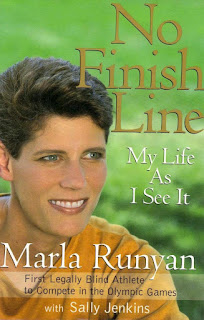(This piece is for my book
titled Pacesetters: Runners Who Informed Me Best and Inspired Me Most. I
am posting an excerpt here each week, this one from January 2002.)
MARLA’S
VISION. I’m a steady
but slow reader. My test of a book’s fascination quotient is how long I take to
finish it.
Usually this is weeks. Seldom do I have the interest, or take the
time, to turn the pages any faster.
Recently, though, I raced through two books in two days apiece.
Both came from the same co-author. Sally Jenkins has mastered the
triumph-over-trouble genre.
She acted as ghost-writer for It’s
Not About the Bike, Lance Armstrong’s best-seller. For an encore she
co-wrote Marla Runyan’s No Finish Line:
My Life As I See It.
Runyan is the only athlete ever to compete in both the Paralympics
(1992 and 1996) and regular Olympics (2000). She also has run in the past two
World Championships.
She is legally blind. But her book could just as well be called, It’s Not About the Eyes.
It isn’t mainly about the eyes, anyway. To know only about her
limited sight is not really to know her at all.
The book tells of her first international victory, in the 1999
Pan-American Games 1500. In only her fourth race ever at this distance she beat
Canadian Leah Pells by one-hundredth of a second.
“The press came at me like a large, anxious creature,” Runyan
recalls. “Tape recorders were thrust in my face, and voices yelled questions at
me simultaneously. Then one voice separated itself from the others.”
A reporter shouted, “Marla, tell us about your eyes.” This
bothered her.
“I wanted to say, ‘Did you watch the race?’ At that moment the
subject of my eyesight seemed the most inappropriate and irrelevant topic I
could think of... Why couldn’t they let my accomplishment stand on its own?”
Runyan writes early in the book, “The truth is, running is the
easiest thing I do. To run a race around a perfectly flat and smooth track, in
a controlled environment, among a group of familiar people all moving at a
similar pace, feels safe to me compared to the effort I have to put forth, and
the menace I confront, in moving through an ordinary day in ordinary life.”
Running is where Marla Runyan has always felt most comfortable,
most at home. There she “sees” with all her senses.
On the track we see only the triumphant final scenes of Marla’s
drama. Before racing as she now does, she had to reshape herself from sprinter
and jumper (she’d competed in the 1996 Olympic Trials as a heptathlete) into a
distance runner.
This didn’t happen quickly or easily. The early efforts led to two
surgeries that cost her two full years of running.
Then in Olympic year 2000 she injured a knee in May, hardly ran at
all until the Trials in July, made the team anyway, and finished eighth in the
1500 at Sydney. She never lost sight of what she intended to do.
I think that without the injury she would have medaled. Her
aggressive, fast-finishing style is that well suited for Olympic-level racing.
The real heroics in the book, though, are acted out away from the
track: becoming a straight-A student in high school and college without seeing
books and blackboards as other students do... fighting with and winning over
her parents and then the license testers to let her drive a car... letting
herself really fall in love for the first time at almost 30... nursing her
ever-supportive mother through cancer.
Marla Runyan and I now share the same hometown. I’m friends with
two of Runyan’s former coaches, Dick Brown and Mike Manley.
But I’ve seen her only in races at Hayward Field and still haven’t
met her. After reading her book, I know her better in the ways she wants to be
known. Not as that blind runner, but as one who sees – and seizes – life her
own way.
UPDATE. Marla Runyan
extended her racing range after this piece appeared. She debuted as a
marathoner at New York City in 2002, and finished as first American. Then she
returned to the track to qualify for her second Olympics, in the 5000.
After having her daughter Anna in 2005, she won the Twin Cities
Marathon the next year. Now retired from racing, Marla teaches the visually
impaired.
[Many
books of mine, old and recent, are now available in two different formats: in
print and as ebooks from Amazon.com. Latest released was Miles to Go. Other
titles: Going Far, Home Runs, Joe’s Journal, Joe’s Team, Learning to Walk, Long
Run Solution, Long Slow Distance, Pacesetters, Run Right Now, Run Right Now
Training Log, See How We Run, and Starting Lines, plus Rich Englehart’s book
about me, Slow Joe.]

No comments:
Post a Comment